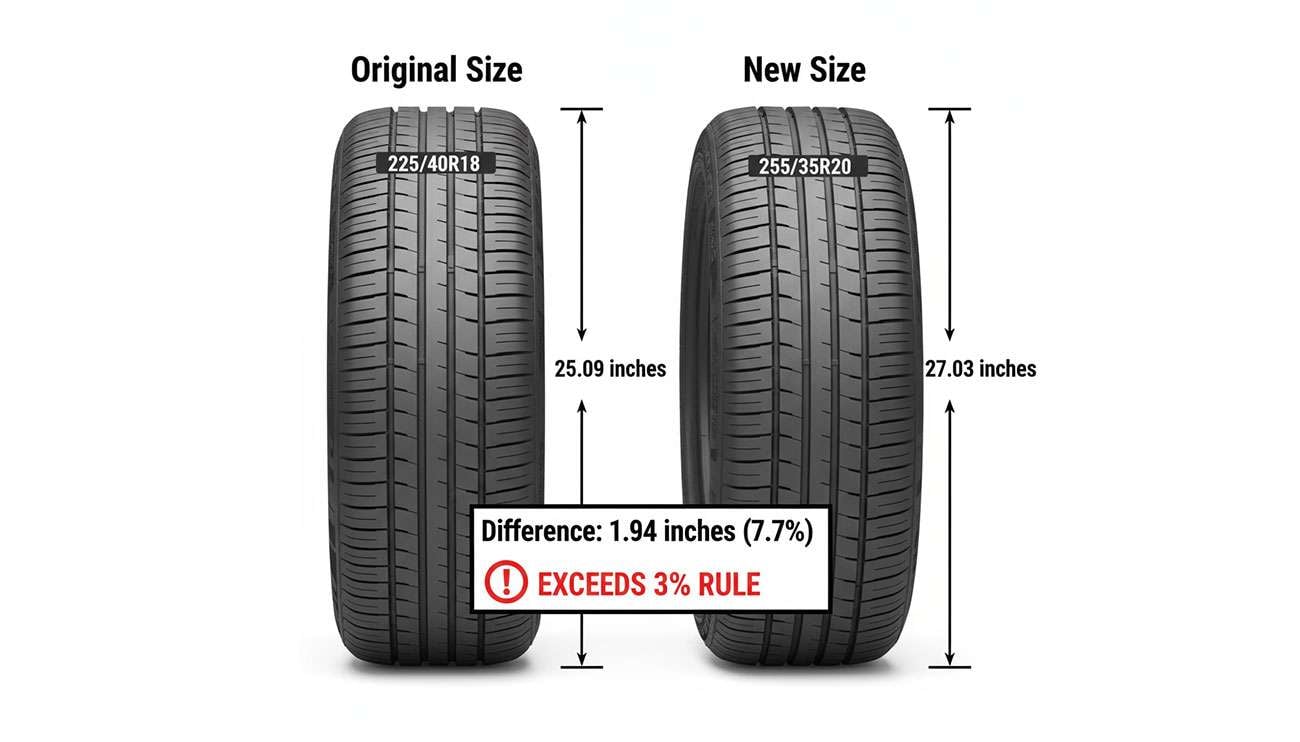
The 3% rule for tires stands as one of the most important guidelines in tire replacement. At Performance Plus Tire, we know that staying within 3% of your original tire's diameter ensures both safety and optimal performance when selecting new tires. This seemingly small percentage can make the difference between proper vehicle handling and potential problems on the road.
Professional tire experts consider the 3% rule the safe limit for changes in your tire's circumference, whether larger or smaller than your original equipment. Understanding tire size becomes crucial when you're comparing different options or using tire chart comparisons. Vehicle regulations do allow some flexibility in tire width, but diameter measurements remain the key factor for maintaining proper vehicle function.
When you're considering plus sizing tires or wondering how much difference in tire size is acceptable, a tiresize calculator helps verify you stay within this critical 3% threshold. Exceeding this limit can affect your vehicle's performance and safety systems, and may even void certain warranties. We believe in helping you make informed decisions that keep you safe while getting the performance you want from your tires.
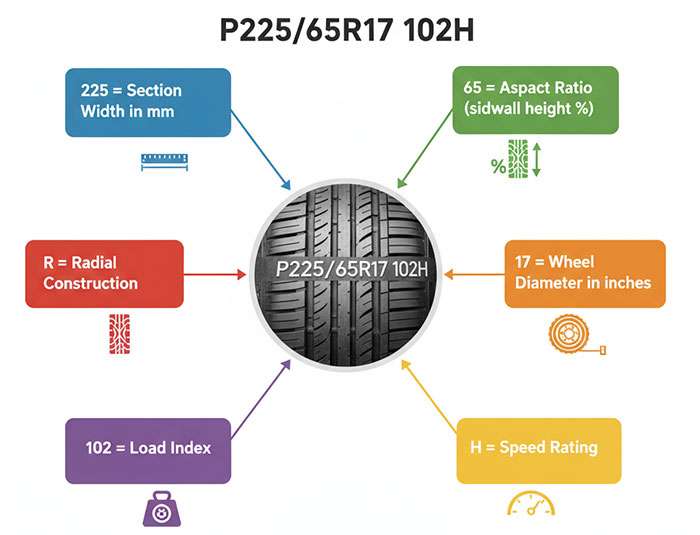
Understanding tire size markings becomes essential when you're planning to replace tires or ensure you're following the 3% rule. The alphanumeric code on your tire's sidewall tells the complete story about its dimensions, load capacity, and performance capabilities. Learning to read these markings helps you make better decisions about tire compatibility.
Every tire size starts with measurements that directly affect your vehicle's handling and performance. Here's how to decode these key components:
Tire width appears as the first three-digit number and represents the tire's width from sidewall to sidewall in millimeters. Take P225/65R17 as an example - the "225" indicates a width of 225mm (approximately 8.9 inches). This measurement determines the contact patch where your tire meets the road, affecting both traction and handling characteristics.
The aspect ratio follows after the slash mark. This two-digit number shows the tire's sidewall height as a percentage of its width. Our P225/65R17 example has "65," meaning the sidewall height equals 65% of the tire's width. Higher aspect ratios create taller sidewalls that offer more cushioning, while lower ratios typically deliver better cornering performance.
Rim diameter comes after the construction indicator (usually "R" for radial) and specifies the wheel diameter in inches. The "17" in P225/65R17 means this tire fits a 17-inch wheel. You must match this measurement exactly when replacing tires - there's no flexibility here.
Breaking down a complete 225/65R17 tire size reveals important details:
The "P" prefix designates a passenger vehicle tire. Other common prefixes include "LT" for light trucks and "ST" for special trailers.
Converting to actual dimensions in inches:
Width: 225mm ÷ 25.4 = 8.9 inches
Sidewall height: 8.9" × 0.65 = 5.7 inches
Overall tire diameter: (5.7" × 2) + 17" = 28.4 inches
Tire markings also include a service description like "91S". The number "91" represents the load index, indicating maximum weight capacity of 1,653 pounds per tire when properly inflated. The letter "S" shows the speed rating - this tire can handle sustained speeds up to 112 mph.
Locating your tire size information is straightforward when you know where to look:
Tire sidewall - The most reliable source, with size markings clearly displayed among other specifications
Driver's side door jamb - Most vehicles feature a tire information sticker here showing manufacturer-recommended tire size and inflation pressure
Vehicle owner's manual - Your glove compartment manual includes a dedicated section for tire specifications
Inside your glove box door - Some vehicles place an additional information sticker here
Within your gas tank hatch - Another common location for the tire information sticker
When shopping for new tires, understanding these codes ensures compatibility with your vehicle and helps you stay within the 3% rule. A tiresize calculator can compare potential replacements against your original equipment, verifying the diameter difference stays within acceptable limits.
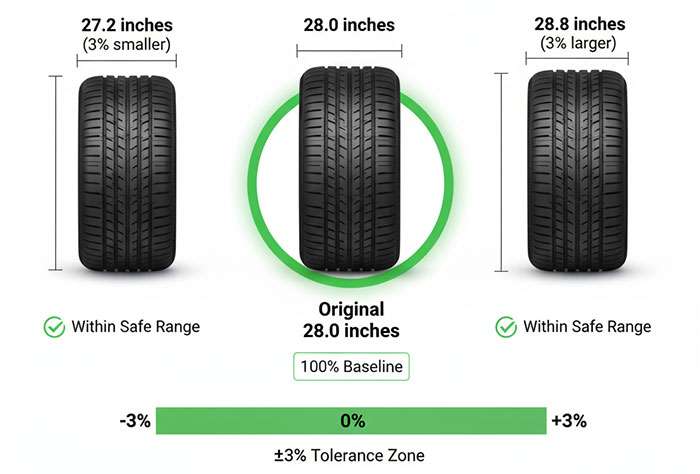
The 3% rule serves as the automotive industry's standard for safe tire replacement. Understanding how this rule works in practice helps explain why proper tire sizing matters far beyond simply fitting your wheels.
The 3% rule establishes that replacement tires should not deviate more than 3% larger or smaller in overall diameter compared to your vehicle's original equipment (OE) tires. This margin represents the accepted safe threshold that preserves handling characteristics and prevents drivetrain stress. The rule focuses specifically on total tire height (diameter), not individual measurements like width or aspect ratio.
For most passenger vehicles, this 3% threshold translates to approximately a 3/4-inch difference in overall diameter. Pickup trucks and SUVs can sometimes accommodate larger variations—up to 15% oversized tires—due to their robust suspension systems and larger wheel wells. However, typical passenger cars risk compromising vehicle dynamics and safety systems when exceeding the 3% threshold.
Some tire professionals recommend an even stricter 2% limit for original equipment tire diameter. This conservative approach provides additional assurance that all vehicle systems function as designed.
Your vehicle's speedometer calibration depends on the original tire's circumference and revolutions per mile. When you change tire diameter, you directly affect how accurately your speedometer reads.
Consider this example: tires that are 3% taller than stock will cause your speedometer to show 60 mph when you're actually traveling at 63.3 mph. This happens because larger tires cover more distance with each rotation, making fewer revolutions per mile than your vehicle's computer expects.
Smaller tires create the opposite problem. Your speedometer indicates a higher speed than your actual velocity, and your odometer records more mileage than you've driven. These inaccuracies can lead to unintended speeding violations or affect maintenance schedules based on mileage readings.
The tire industry generally agrees on these guidelines for acceptable diameter variations:
Conservative approach: Some tire calculators flag differences exceeding 2% as potentially problematic
Standard recommendation: Most experts consider staying within 3% safe for proper vehicle function
Maximum tolerance: Up to 5% difference may work for some applications, though vehicle systems might require reprogramming
Exceeding these thresholds affects more than speedometer accuracy. Differences greater than 5% can impact anti-lock braking systems (ABS) and electronic stability control, since these systems rely on accurate wheel speed data. Oversized tires might also rub against wheel wells or body components during cornering or when hitting bumps.
Before making tire size changes, use a tiresize calculator to compare diameter, circumference, and revolutions per mile between your current tires and potential replacements. This step ensures you stay within the crucial 3% threshold while maintaining both performance and safety.
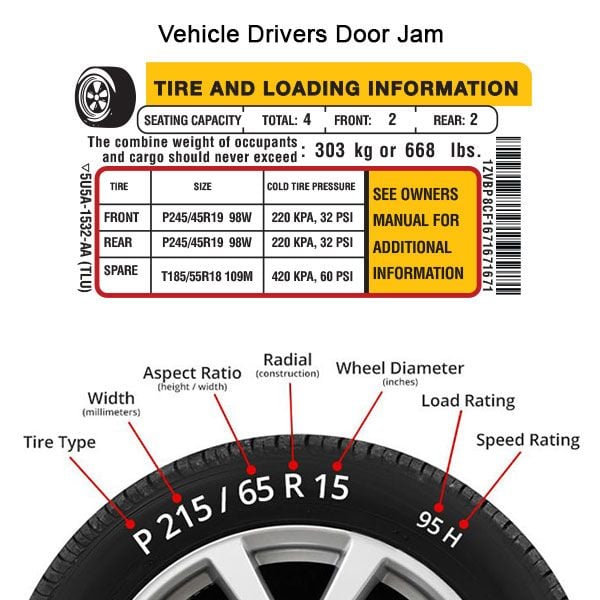
Tire calculators provide essential support when you're considering tire size changes while maintaining vehicle performance. These online tools help ensure your tire choices stay within the critical 3% rule, preventing potential problems with vehicle systems and performance.
Getting accurate results from a tiresize calculator starts with gathering the right information from your current tires and potential replacements. Here's what you need to collect:
Locate your current tire's sidewall markings or vehicle door placard for the original specifications
Identify three critical numbers: width (first number), aspect ratio (second number after the slash), and wheel diameter (third number)
Enter these same specifications for both your current tires and the potential replacement set
Most calculators let you input these values directly. Some advanced options might allow you to select your vehicle's make, model, and year to automatically populate original tire information. The calculator then processes this data to provide comparison results that help determine compatibility.
After entering your tire specifications, the calculator generates several important measurements that determine whether your new tires comply with the 3% rule:
Tire diameter: The overall height of the tire from one side to the other
Circumference: The distance around the tire's outer edge
Revolutions per mile: How many times the tire rotates to travel one mile
The revolutions per mile measurement affects speedometer accuracy directly. For example, if your original tire makes 720 revolutions per mile but your new tire makes only 695 revolutions per mile, your actual speed will be faster than what your speedometer displays.
Focus on keeping the diameter difference within 3% of your original tires. If any measurements differ significantly from your original tires, you should reconsider your choices or consult with tire professionals at Performance Plus Tire for expert guidance.
While tire calculators provide valuable guidance, they do have limitations worth understanding:
Online calculators work best for general comparison purposes rather than as the sole basis for purchasing decisions. Actual tire dimensions may vary slightly from manufacturer specifications, and real-world factors can influence tire performance beyond mathematical calculations.
These tools cannot account for all vehicle-specific factors such as suspension geometry, brake clearance, or manufacturer-specific calibration settings. A calculator might suggest a tire fits mathematically, but physical limitations could still cause rubbing or interference.
Use calculators as a starting point, then seek confirmation from tire professionals before finalizing your purchase decision. This approach ensures you get both the mathematical compatibility and real-world fitment verification you need.
Changing your tire size beyond the 3% rule affects more than just performance—it directly impacts critical vehicle safety systems. These effects explain why staying within recommended parameters matters for safe driving.
Electronic braking systems depend on accurate wheel speed readings. Anti-lock braking systems (ABS) and traction control monitor wheel speeds to detect slippage. When tire diameter changes exceed 3%, these systems may incorrectly interpret normal wheel rotation as tire slip or spin.
Diameter is the critical factor here—not width—as changing tire width alone typically doesn't create issues for these systems. Professional technicians understand this relationship. Ducati motorcycle technicians specifically recalibrate their vehicles' systems after tire changes, even when using the same size but different models.
Larger tires create immediate accuracy problems. They cover more distance per rotation, causing speedometers to display slower speeds than your actual velocity. With tires just 3% larger than original equipment, your speedometer would read 60 mph when you're actually traveling at 63.3 mph.
Your odometer faces the same problem. At 1,000 miles driven on larger tires, the system might only record about 800 miles. Most vehicle computers cannot be easily recalibrated without specialized equipment. This creates ongoing inaccuracy that affects maintenance schedules and resale value.
Tire Pressure Monitoring Systems (TPMS) remain functional with different sized tires, as they simply monitor pressure fluctuations. When changing tire sizes, TPMS sensors should be transferred to the new wheels. Some systems require "relearning" procedures when sensors move positions.
Sensor repositioning requires replacing components including valve caps, cores, nuts, and rubber grommets to prevent leaks. Certain vehicles require dealer assistance for sensor registration—Toyota and Lexus models specifically need sensor ID codes programmed using dealer-only tools. Understanding these requirements prevents costly installation problems.
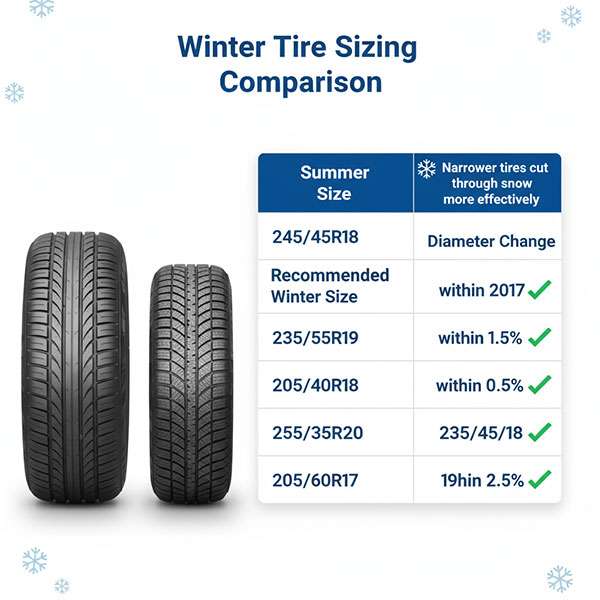
Changing tire sizes can provide real performance benefits when done properly. The key is understanding when these changes make sense for your driving needs while maintaining vehicle safety.
Winter driving conditions often favor narrower tires. Smaller contact patches cut through snow more effectively than wide tires, which tend to ride on top of snow rather than penetrating it. This advantage becomes especially important if your vehicle currently runs ultra-wide tires (275mm or wider).
However, winter downsizing must respect the same diameter limits we've discussed. Use a tire size calculator to verify that your winter tire choice maintains proper circumference. This ensures your speedometer remains accurate and prevents stress on drivetrain components during those challenging winter months.
Plus sizing offers three distinct approaches for performance enhancement:
Plus Zero keeps your current wheel size while increasing tire width and reducing sidewall height. You get improved grip without buying new wheels.
Plus One steps up wheel diameter by 1 inch, adds 10mm to tire width, and drops aspect ratio by 10 points. This provides better handling response.
Plus Two takes the concept further with 2-inch larger wheels, 20mm wider tires, and 20-point lower aspect ratio. The result is maximum performance improvement with more dramatic appearance changes.
Proper clearance becomes critical when changing tire dimensions. Maintain at least 1/4-inch clearance throughout the wheel well, though 1/2-inch provides better insurance against tire growth and sidewall deflection.
Most importantly, verify brake caliper clearance before finalizing your selection. Larger wheels don't automatically guarantee adequate space for brake components. Our expert team at Performance Plus Tire can help verify proper fitment and guide you through the selection process to ensure your upgrade delivers the performance you're looking for.
The 3% rule provides a simple but essential guideline for safe tire replacement. This principle helps maintain your vehicle's performance, safety, and reliability while preventing problems with speedometer accuracy, ABS functionality, and handling characteristics.
Learning to decode tire size markings gives you valuable information when shopping for replacements. A reliable tire size calculator ensures your selection falls within the acceptable range. You can find detailed tools and expert guidance at Performance Plus Tire to help make these important decisions.
Exceeding the 3% rule affects crucial vehicle systems like traction control and TPMS. While trucks and SUVs can sometimes handle up to 15% difference, most passenger vehicles perform best within the standard 3% guideline.
Whether you're downsizing for winter driving or upsizing for improved performance, the same rule applies. Maintaining proper clearance and respecting the 3% threshold ensures your modifications enhance rather than compromise your vehicle's safety systems. Those three percentage points might seem small, but they make a significant difference in how safely your vehicle performs on the road.
Ready to find the right tires for your vehicle? Our expert team can help you select tires that meet the 3% rule while delivering the performance you want.
The 3% rule is your safety net when changing tire sizes, ensuring optimal vehicle performance while preventing costly system malfunctions.
Stay within 3% of original tire diameter - This industry standard prevents speedometer errors, ABS issues, and drivetrain stress while maintaining vehicle safety systems.
Use tire calculators before purchasing - Input original and new tire specifications to verify diameter differences stay within acceptable limits and avoid compatibility problems.
Larger tires create speedometer inaccuracy - A 3% increase means your speedometer shows 60 mph when actually traveling 63.3 mph, affecting both speed readings and odometer accuracy.
Safety systems rely on proper tire sizing - ABS, traction control, and electronic stability systems use wheel speed data that becomes unreliable when tire diameter exceeds recommended thresholds.
Plus sizing requires careful calculation - Whether downsizing for winter tires or upsizing for performance, maintain the 3% rule and ensure adequate wheel well clearance to prevent rubbing.
Remember: While trucks and SUVs may handle up to 15% oversized tires, passenger vehicles should strictly follow the 3% guideline to preserve manufacturer-designed performance and safety characteristics.
The 3% rule states that when replacing tires, the new tire's diameter should not differ from the original by more than 3%. This guideline helps maintain proper vehicle performance, safety system functionality, and speedometer accuracy.
Exceeding the 3% rule can lead to inaccurate speedometer readings, increased stress on the drivetrain, and potential issues with safety systems like ABS and traction control. It may also affect handling and stability, especially in adverse driving conditions.
Yes, online tire size calculators are valuable tools for comparing original and potential replacement tire sizes. They help determine if new tires fall within the 3% guideline by calculating differences in diameter, circumference, and revolutions per mile.
Yes, you can upsize or downsize tires safely as long as you stay within the 3% rule. For winter driving, slight downsizing can improve traction. When upsizing, ensure proper wheel well clearance and consider the impact on vehicle systems.
While the 3% rule is a general guideline for most vehicles, some trucks and SUVs can accommodate up to 15% oversized tires due to their more robust suspension systems and larger wheel wells. However, it's still important to consider the impact on vehicle systems and performance.